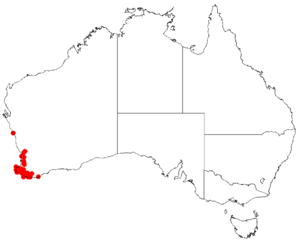Hakea lasianthoides facts for kids
Quick facts for kids Hakea lasianthoides |
|
|---|---|
| Scientific classification | |
| Genus: |
Hakea
|
| Species: |
lasianthoides
|
 |
|
| Occurrence data from AVH | |
The Hakea lasianthoides is a special kind of shrub or small tree. It belongs to the Proteaceae plant family. This plant is only found in Western Australia, which means it is endemic there. It has pretty creamy-white flowers and long, thin leaves. You can see it bloom from September to November.
What Does Hakea lasianthoides Look Like?
The Hakea lasianthoides usually grows straight up. It can reach a height of about 1.5 to 3.5 meters (5 to 11.5 feet). This plant does not have a special woody base called a lignotuber. A lignotuber helps some plants regrow after a fire.
Its leaves are flat and stay green all year. They are shaped like a line or a narrow oval. Each leaf is about 3 to 11.5 centimeters (1 to 4.5 inches) long. They are also about 3 to 11 millimeters (0.1 to 0.4 inches) wide.
This Hakea blooms between September and November. It produces lovely white or cream-colored flowers. Each group of flowers, called an inflorescence, has 2 to 8 individual flowers. These flowers are cream-colored and have tiny hairs on their outer parts. These parts are called the perianth and are about 4.5 to 7 millimeters (0.18 to 0.28 inches) long.
After the flowers, smooth, leaf-like fruits grow. They are shaped like a wide oval. Each fruit is about 25 to 31 millimeters (1 to 1.2 inches) long. Inside, the seeds are shaped like a narrow oval. They have a small wing on one side to help them spread.
How Did Hakea lasianthoides Get Its Name?
A botanist named Barbara Rye first officially described this plant. She did this in 1984. Her work was published in a science journal called Nuytsia.
The plant's scientific name, lasianthoides, comes from Greek words. Lasios means "hairy" or "woolly". Anthos means "flower". And -oides means "resembling" or "like". So, lasianthoides means "resembling hairy flowers". This name was chosen because its flowers look similar to another plant, Hakea lasiantha.
Where Does Hakea lasianthoides Grow?
The Hakea lasianthoides is found only in certain parts of Western Australia. This means it is endemic to these areas. You can find it in the South West and Great Peel regions. Its range stretches from Armadale in the north down to Denmark in the south.
This plant likes to grow in damp places and on top of ridges. It prefers sandy-loam and gravelly soils. You will often see it growing as part of the plants under the taller trees in a Jarrah forest.

